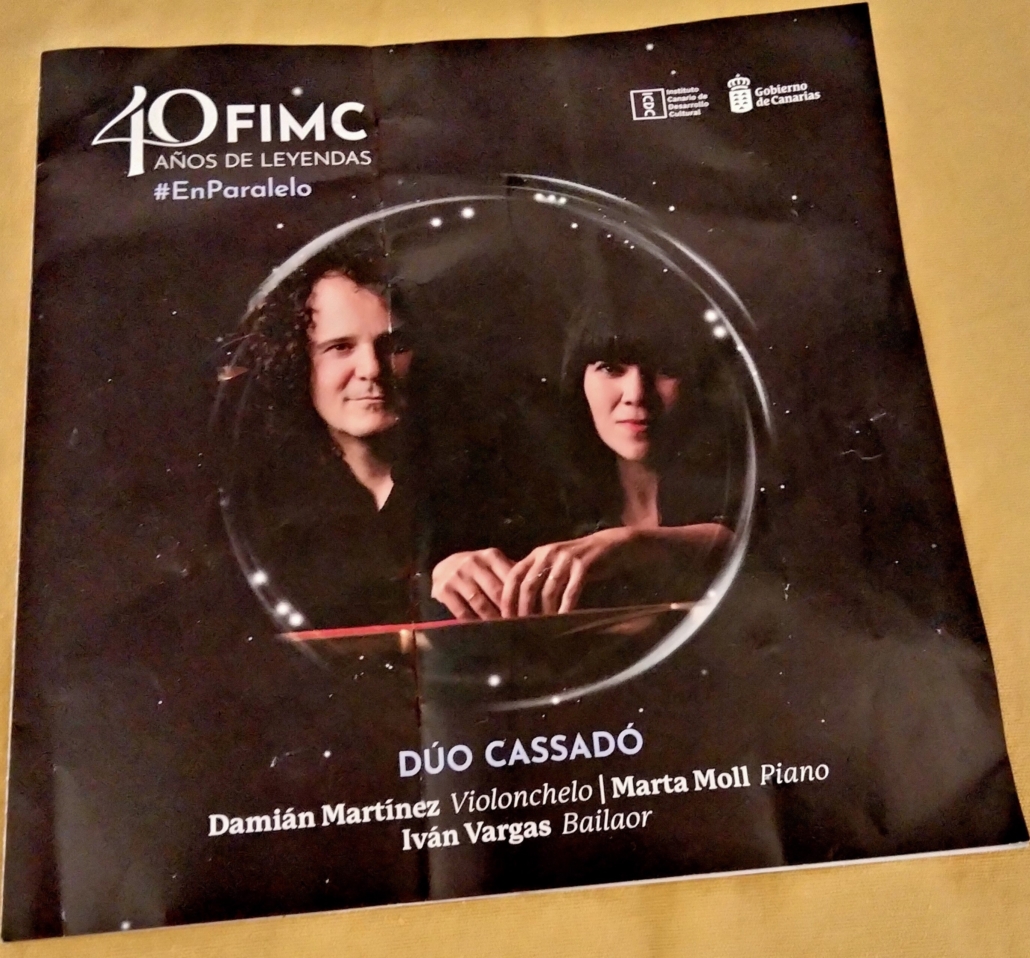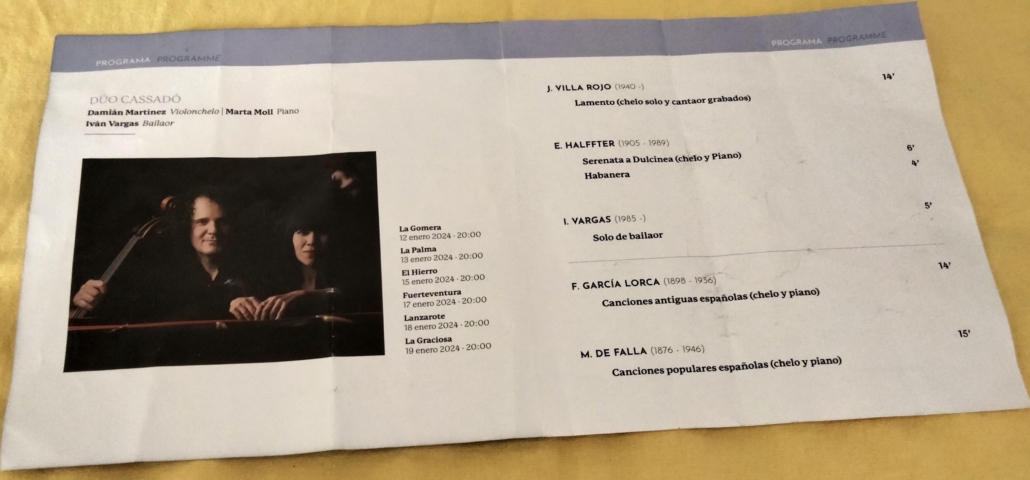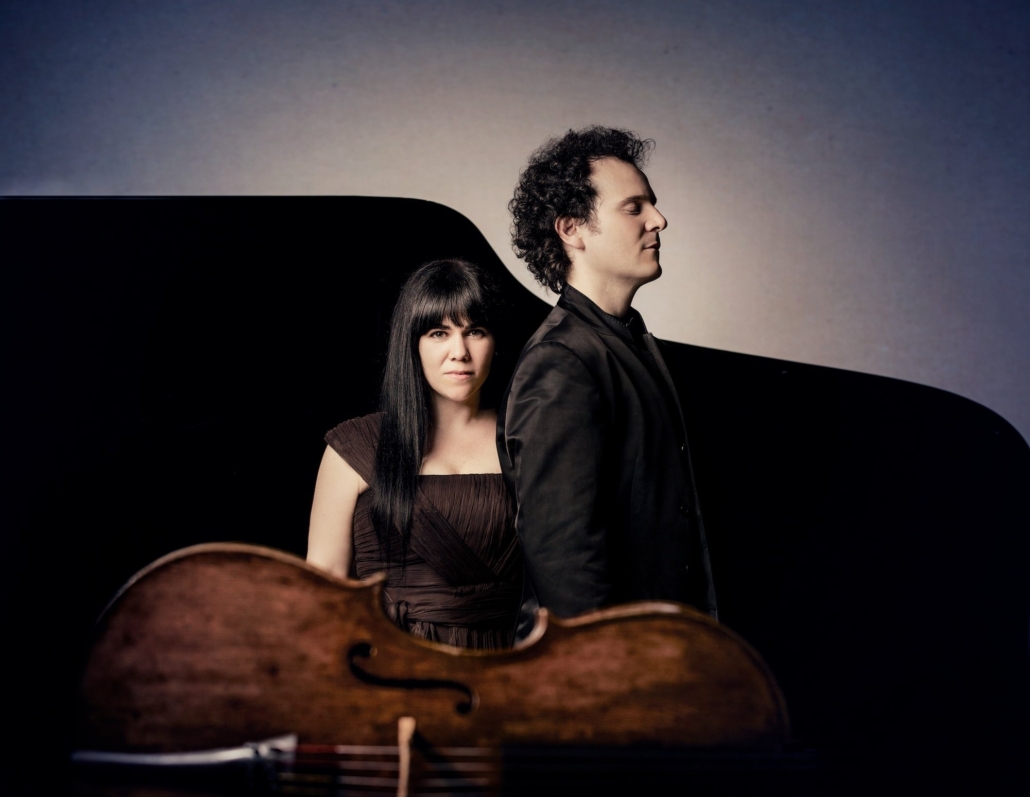DUO CASSADO
DUO CASSADO,
Teatro Municipal, Tias, Lanzarote, January 2024
40th FESTIVAL INTERNACIONAL
de MUSICA de CANARIA

We spend a year looking forward to this wonderful annual classical music festival that has acts from all over Europe sailing and flying around the islands with all their instruments and luggage, on slightly different itineraries but all part of what must be a logistical nightmare. Imagine all the time table lateness and mishaps that could take place on such a long and complicated tour that involves symphony orchestras, chamber music ensembles, duos and soloists and dancers.
We only travelled a 40k round trip, to the north of our Playa Blanca homes, and we had set off in what we thought was plenty of time to be prompt for our reserved table at Arrayate un Millo, our favourite pre-concert restaurant in Tias. However, it took us forever to find a parking place anywhere near the theatre so we had to run as fast as we could, although it was probably only walking pace for younger sprightlier people, and arrived at the restaurant with only a minute or two left on the clock, only to find the beautiful dining room more or less deserted.
We took our seats, ordered our drinks and then began a conversation between the four of us, my wife Dee and I and two of our reporters, who wish to remain anonymous, for our Sidetracks and Detours daily blog. We spoke wildly and speculatively about why the place seemed so empty and yet the town seemed so full. With this restaurant being only yards from the theatre and with the rest of the town packed with parked cars, we wondered if there was perhaps a rival event that might detract from the concert audience.
Nevertheless we ordered our bottle of wine for the ladies and two cold beers for me and my mate, and each of us selected our own choice from what is an eclectic menu of typical Spanish food, beautifully presented. Even the humble dish that is called ´broken egg´, is beautifully presented. It consists of strips of Iberian ham laid on two fried eggs, themselves embedded on a fried potato underlay. It was all good stuff and the Üruguayan dessert I had was a rich, creamy bowl of meringue and we idled away ninety minutes until it was time to walk round the corner to the theatre. By that time Arrayate un Millo had filled up to an every-table-taken buzz so we already felt reassured this would be a well-attended concert, and were proven right in that assumption when we reached the theatre. It was heaving and we bumped into old friends like Carmen and Marco who we invariably meet at such events. Our incorrigible female undercover reporter was starting conversations in all directions gathering stories for her pages.
This was our first visit to see one of the eight Lanzarote concerts to be performed by musicians touring the Canary Islands as part of this year´s 40th Anniversary.
The Cassadó Duo, formed by the cellist Damian Martínez and the pianist Marta Moll, presented a performance entitled ‘Hechizo y duende’, in tribute to Federico García Lorca, on the 125th anniversary of the birth of the poet and playwright.
This was a show that fused classical music, flamenco, dance and poetry, with the collaboration of Iván Vargas, one of the genre´s most well-known and respected flamenco dancers. The repertoire included music compiled and harmonized by Lorca himself, Falla and Halffter, as well as a recent creation by Jesús Villa Rojo entitled ‘Lamento’.
‘Hechizo y duende’ is part of the recording that Lorca made with Encarnación López ‘La Argentinita’, and through the wonders of technology we heard Lorca himself at the piano and the mythical dancer singing, tapping and playing the chopsticks
As writer Ian Gibson has stated, ´Lorca’s work and life cannot be explained without taking into account the fact that Federico was a born musician. As a great lover of popular heritage, he studied different treatises and songbooks, and harmonized thirteen old Spanish songs from different parts of Spain´.
Perhaps because he was a poet and musician and / or perhaps because he was a victim of assassination, I have always felt that Lorca´s life might have been romanticised over the years but Gibson´s statement, which I had not known until researching this article seems to suggest that it is for his music and poetry that Lorca is most loved and remembered by. That Leonard Cohen turned a Lorca piece, which he called Take This Waltz, into a world famous song, has helped sustain the Lorca legacy and certainly in the UK folk club circuit of the eighties and nineties there were acts performing and recording Lorca music. More famous names like Tim Buckley and Joan Baez also introduced his work to new audiences.

And now The Cassadó Duo has made a transcription for cello and piano of the Canciones Antigua Españolas, which formed a core part of the show.
Homage to F. García Lorca on the 125th Anniversary of his birth)
J. Villa Rojo: Lamento( cantaor y chelos grabados)
E. Halffter: Serenade to Dulcinea (Cello and Piano)
E. Halffter: Habanera
I. Vargas: Solo de bailaor
F. García Lorca: Old Spanish songs (cello and piano)
M. de Falla: Spanish folk songs (cello and piano)
When Damien stepped out alone onto the stage and approached his cello, placed centre stage, there was massive applause. The solo piece he delivered to open the show clearly previewed what we later saw. This opening number included the ´trick´ of having Lorca playing in the recorded background as Damien delivered a cello master-class. It contained all the emotions we associate with the instrument, love, passion, yearning and at times even desolation. There was an almost call-to-prayer feel about it that reminded me of the score of a film called Atonement if I remember correctly.
As the piece closed and the applause finally relented, Marta Moss stepped through the curtains, resplendent in a black dress and a red flowing jacket, and took to the piano at the left of the stage. The theatre lights dimmed but rows of ´fairy lighting´ ran along the top of the piano and beneath the keyboard. She played her solo piece and I was feeling confident already that we were listening to a Duo Cassadó that contained two international class musicians, and whenever they played in combination throughout the rest of the evening they somehow enhanced each other´s already impeccable work.
In these early stages we had no idea of what would take place to further enhance what we had thought of as beyond enhancement.
The duo were then joined on stage by the huge presence of Ivan Vargas, the aforementioned dancer. He has an imposing physicality, an agility and lightness that belies his frame and he carries a dignity and obvious respect for flamenco and its history of being both a social reflector and a social influencer. At times his dance was as quiet and soft as Mr. Bojangle´s old soft shoe and at other times he was stomping or tapping and clapping or finger clicking. Whatever sounds he made perfectly complemented the wonderful musicality of Duo Cassadó. As he danced, the lighting threw giant shadows of him along the theatre walls
Dancer and duo did not acknowledge each other, or even look at each other, until the final encore. This was true homage; to Lorca the musician, to history and to the role of flamenco in creating that history.
The piano work was gorgeous and was complemented by a cello that seemed to be speaking to us, and both were balanced by the incredible dance, and all of it was accompanied by an informative and educational cinema-screened history, in photographs and text, of all we were listening to and seeing.
It had been a riveting recital and performance that fully deserved the standing ovation and calls for an encore.
The three artists delivered that encore with perhaps the most light-hearted piece of the evening, in which for the first time really, Ivan and Damien and Marta acknowledged one another. Ivan leaned over the piano and had his hands ´echo´ her finger placements, and then put his ear to the side of Damien´s cello and swayed and swooned to its sounds.
I sincerely hope that this presentation might be recorded in audio and video formats so that we might be able to purchase a copy to show our friends why this was one of these rare occasions when we truly knew we had been in the presence of greatness.
The drive home was down the long but unlit dual carriage way back to Plays Blanca and although that is a road we travel every day we got lost even before we had left Tias and given how dark it was we pretty much crawled the rest of the way home.
Do you think that might be why I haven´t been invited to join this smooth-flowing Canary Island tour as its in house reporter?





Leave a Reply
Want to join the discussion?Feel free to contribute!